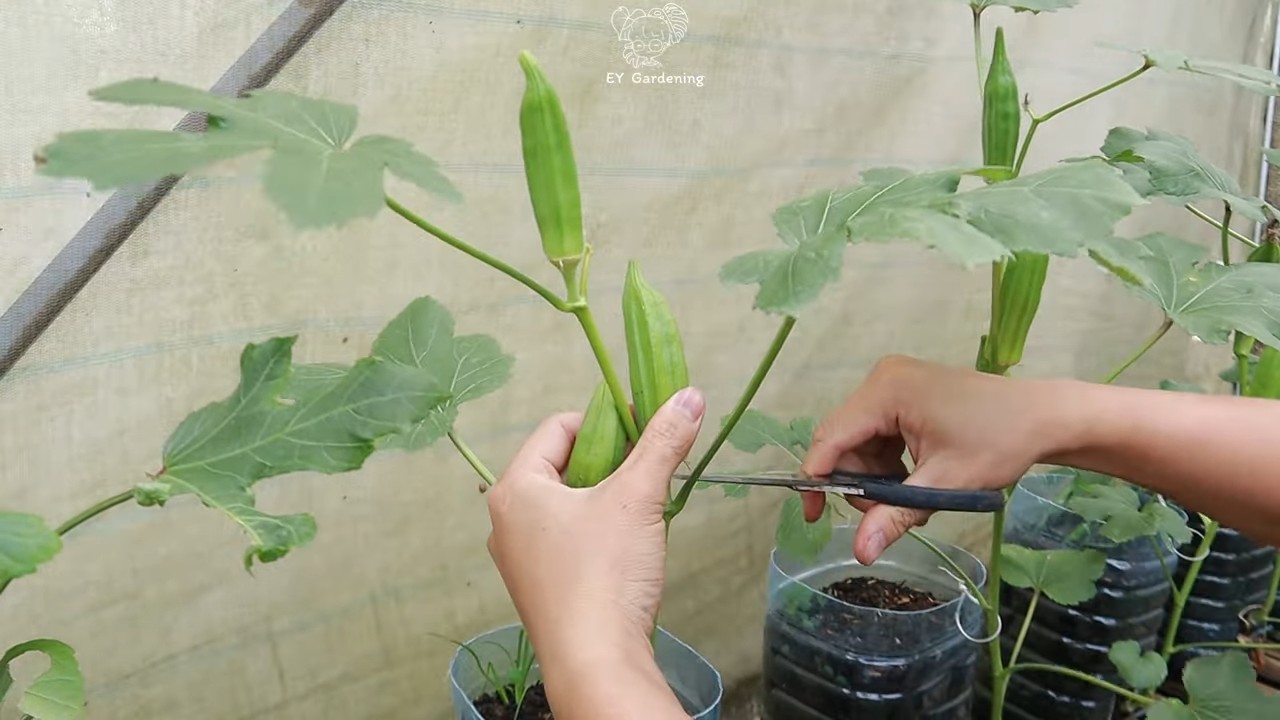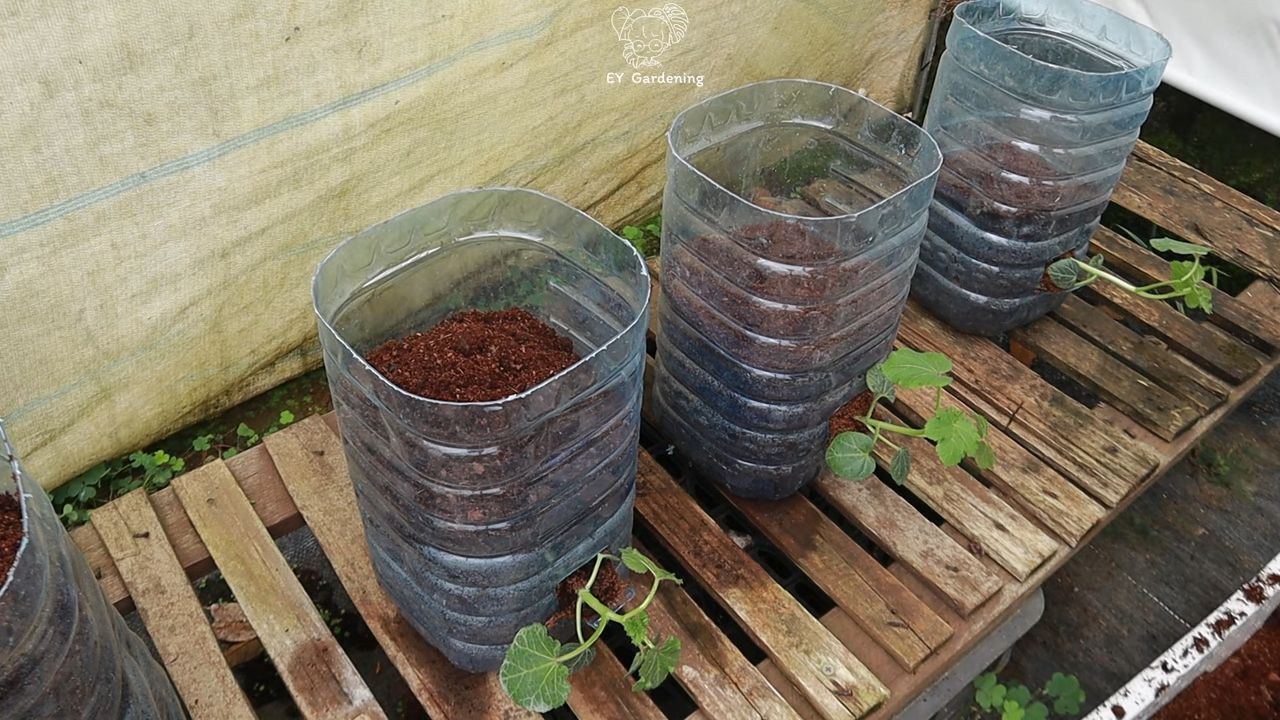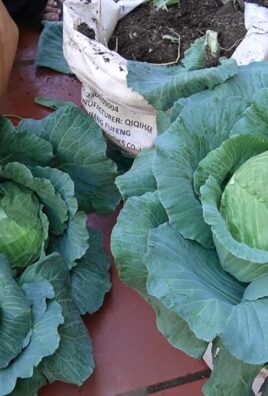Rooftop okra growing might sound like a far-fetched dream, especially if you’re living in a bustling city! But trust me, it’s more achievable than you think, and I’m here to show you how. Imagine stepping out onto your rooftop and harvesting fresh, vibrant okra – a true farm-to-table experience right in your own urban oasis.
Okra, also known as “lady’s fingers,” has a rich history, tracing back to ancient Ethiopia and Egypt. It then spread across the globe, becoming a staple in cuisines from the American South to India. For generations, okra has been cherished not only for its unique flavor and texture but also for its nutritional benefits.
But why should you consider rooftop okra growing? Well, in today’s world, where access to fresh, locally sourced produce can be limited, especially in urban areas, growing your own food offers a fantastic solution. Plus, let’s be honest, there’s something incredibly satisfying about nurturing a plant from seed to harvest. This DIY guide will provide you with simple, effective tricks and hacks to successfully cultivate okra on your rooftop, regardless of your gardening experience. We’ll cover everything from choosing the right containers and soil to providing adequate sunlight and water, ensuring you enjoy a bountiful harvest of delicious okra. Get ready to transform your rooftop into a thriving edible garden!

Rooftop Okra Oasis: A DIY Guide to Growing Okra in the Sky!
Hey there, fellow green thumbs! Ever dreamed of having a little slice of the South right on your rooftop? Well, get ready to make that dream a reality! I’m going to walk you through everything you need to know to grow a thriving okra patch high above the ground. Okra is surprisingly easy to grow, and the fresh, homegrown flavor is unbeatable. Plus, imagine the bragging rights! Let’s get started!
Choosing the Right Okra Variety
Before we dive into the nitty-gritty, let’s talk okra varieties. Not all okra is created equal, and some are better suited for container gardening than others. Here are a few of my favorites:
* Clemson Spineless: This is a classic for a reason! It’s productive, relatively compact, and the pods are tender. It’s a great all-around choice for beginners.
* Burgundy: If you want to add a pop of color to your rooftop garden, Burgundy okra is the way to go! The pods are a beautiful deep red, and they taste just as good as they look.
* Dwarf Green Long Pod: As the name suggests, this variety stays relatively small, making it perfect for containers. It produces long, slender green pods.
* Emerald: This variety is known for its smooth, spineless pods, making harvesting a breeze. It’s also a heavy producer.
Gathering Your Supplies
Okay, now that we’ve picked our okra stars, let’s gather our supplies. Here’s what you’ll need:
* Large Containers: Okra needs room to grow, so choose containers that are at least 18 inches in diameter and 18 inches deep. Fabric pots are a great option because they allow for good drainage and airflow.
* High-Quality Potting Mix: Don’t skimp on the potting mix! Use a well-draining mix that’s specifically formulated for containers. Avoid using garden soil, as it can become compacted in containers.
* Okra Seeds: Of course! Make sure you get your seeds from a reputable source.
* Slow-Release Fertilizer: Okra is a heavy feeder, so a slow-release fertilizer will provide it with the nutrients it needs throughout the growing season.
* Watering Can or Hose: You’ll need a way to water your okra plants regularly.
* Gardening Gloves: Protect your hands from thorns and dirt!
* Trowel or Small Shovel: For planting and transplanting.
* Pruning Shears or Scissors: For harvesting okra pods.
* Optional:
* Trellis or Stakes: Some okra varieties can get quite tall, so you may want to provide support.
* Mulch: Mulch helps retain moisture and suppress weeds.
* Insecticidal Soap or Neem Oil: For dealing with pests.
Step-by-Step Planting Guide
Alright, let’s get our hands dirty! Here’s how to plant your okra seeds:
1. Soak the Seeds: To improve germination, soak your okra seeds in warm water for 12-24 hours before planting. This will help soften the seed coat and speed up the sprouting process.
2. Fill the Containers: Fill your containers with the high-quality potting mix, leaving about an inch or two of space at the top.
3. Plant the Seeds: Make small holes about 1/2 inch deep and 2-3 inches apart. Place 2-3 seeds in each hole. Planting multiple seeds ensures that at least one will germinate.
4. Cover the Seeds: Gently cover the seeds with potting mix and water thoroughly.
5. Keep the Soil Moist: Keep the soil consistently moist, but not waterlogged, until the seeds germinate. You can cover the containers with plastic wrap to help retain moisture.
6. Provide Warmth: Okra loves warmth! Place the containers in a sunny spot where they’ll receive at least 6-8 hours of direct sunlight per day.
7. Thin the Seedlings: Once the seedlings emerge (usually in 7-14 days), thin them to one plant per hole. Choose the strongest, healthiest-looking seedling and snip off the others at the soil line.
Caring for Your Rooftop Okra
Now that your okra plants are growing, it’s time to give them the TLC they need to thrive.
1. Watering: Water your okra plants deeply and regularly, especially during hot, dry weather. Aim to keep the soil consistently moist, but avoid overwatering, which can lead to root rot. Check the soil moisture by sticking your finger into the soil. If the top inch feels dry, it’s time to water.
2. Fertilizing: Okra is a heavy feeder, so fertilize your plants regularly with a balanced fertilizer. Follow the instructions on the fertilizer package. You can also supplement with compost tea or fish emulsion.
3. Sunlight: Okra needs at least 6-8 hours of direct sunlight per day. If your rooftop doesn’t get enough sun, you may need to supplement with grow lights.
4. Weeding: Keep the containers free of weeds, which can compete with your okra plants for nutrients and water.
5. Pest Control: Keep an eye out for pests like aphids, spider mites, and okra stink bugs. If you spot any pests, treat them with insecticidal soap or neem oil.
6. Support: Some okra varieties can get quite tall and may need support. You can use a trellis or stakes to keep the plants from falling over.
7. Mulching: Apply a layer of mulch around the base of the plants to help retain moisture, suppress weeds, and regulate soil temperature.
Harvesting Your Okra Bounty
The moment you’ve been waiting for! Harvesting your homegrown okra is so rewarding.
1. Timing is Key: Okra pods are best harvested when they’re young and tender, usually about 2-4 inches long. Overripe pods can become tough and woody.
2. Check Daily: Check your okra plants daily for ripe pods. Okra grows quickly, so you’ll need to harvest frequently.
3. Use Pruning Shears or Scissors: Use pruning shears or scissors to cut the pods from the plant. Be careful not to damage the plant.
4. Wear Gloves: Okra pods can be prickly, so wear gloves to protect your hands.
5. Harvest Regularly: Harvesting regularly encourages the plant to produce more pods.
6. Enjoy Your Harvest: Okra is delicious fried, grilled, stewed, or pickled. Experiment with different recipes and enjoy the fruits (or rather, pods) of your labor!
Troubleshooting Common Okra Problems
Even with the best care, you might encounter a few problems along the way. Here are some common issues and how to deal with them:
* Yellowing Leaves: This could be a sign of nutrient deficiency, overwatering, or underwatering. Check the soil moisture and fertilize your plants if needed.
* Stunted Growth: This could be caused by poor soil, lack of sunlight, or pests. Make sure your plants are getting enough sunlight and nutrients, and check for pests.
* Lack of Pod Production: This could be due to lack of pollination, high temperatures, or over-fertilizing with nitrogen. Make sure your plants are getting enough sunlight and water, and avoid over-fertilizing with nitrogen. You can also try hand-pollinating the flowers.
* Pest Infestations: Keep an eye out for pests like aphids, spider mites, and okra stink bugs. Treat them with insecticidal soap or neem oil.
Extending the Harvest
Want to keep the okra coming? Here are a few tips for extending the harvest:
* Succession Planting: Plant new okra seeds every few weeks to ensure a continuous harvest.
* Deadheading: Remove spent flowers to encourage the plant to produce more pods.
* Fertilizing: Continue to fertilize your plants regularly to keep them producing.
* Watering: Water your plants deeply and regularly, especially during hot, dry weather.
Safety First!
Before you start hauling soil and containers onto your roof, let’s talk safety.
* Check Your Roof’s Load Capacity: Make sure your roof can handle the weight of the containers, soil, and water. Consult with a structural engineer if you’re unsure.
* Waterproofing: Protect your roof from water damage by using waterproof containers and liners.
* Accessibility: Make sure you have easy and safe access to your rooftop garden.
* Sun Protection: Wear sunscreen, a hat, and sunglasses when working in your rooftop garden.
* Stay Hydrated: Drink plenty of water,

Conclusion
So, there you have it! Transforming your rooftop into a thriving okra patch is not just a whimsical dream; it’s an achievable reality with a little planning and effort. We’ve explored the ins and outs of rooftop okra growing, from selecting the right varieties to ensuring proper drainage and sunlight exposure. But why should you embark on this green adventure?
First and foremost, growing your own okra offers unparalleled freshness and flavor. Imagine plucking plump, vibrant okra pods straight from your rooftop garden and incorporating them into your favorite gumbo or stir-fry. The taste difference compared to store-bought okra is simply remarkable. Beyond the culinary benefits, rooftop gardening provides a therapeutic escape from the hustle and bustle of city life. Tending to your okra plants can be a meditative experience, allowing you to connect with nature and de-stress amidst the urban landscape.
Furthermore, rooftop okra growing is an environmentally friendly practice. By growing your own food, you reduce your carbon footprint associated with transportation and packaging. You also have complete control over the growing process, ensuring that your okra is free from harmful pesticides and herbicides. Plus, a rooftop garden can help insulate your building, reducing energy consumption and saving you money on utility bills.
But the possibilities don’t end there! Feel free to experiment with different okra varieties to discover your personal favorites. Clemson Spineless is a classic choice known for its smooth pods and excellent flavor. Burgundy okra adds a splash of color to your garden with its deep red pods. For those with limited space, dwarf varieties like Baby Bubba are ideal for container gardening.
Consider companion planting to enhance the growth and flavor of your okra. Basil, marigolds, and peppers are excellent companions that can deter pests and attract beneficial insects. You can also add a trellis or support system to encourage vertical growth, maximizing space and creating a visually appealing garden.
Don’t be afraid to get creative with your rooftop garden design. Incorporate other vegetables, herbs, and flowers to create a diverse and vibrant ecosystem. Add seating and decorative elements to transform your rooftop into a relaxing and inviting outdoor space.
We understand that rooftop gardening can seem daunting at first, but with the right knowledge and resources, anyone can succeed. Start small, be patient, and don’t be afraid to learn from your mistakes. The rewards of rooftop okra growing are well worth the effort.
We encourage you to take the plunge and transform your rooftop into a flourishing okra oasis. Share your experiences, successes, and challenges with us in the comments below. We’d love to hear about your rooftop okra growing journey and learn from your insights. Let’s create a community of rooftop gardeners and inspire others to embrace sustainable urban agriculture. Happy gardening!
Frequently Asked Questions (FAQ)
What are the best okra varieties for rooftop gardening?
The best okra varieties for rooftop gardening are those that are well-suited for container growing and can tolerate the specific conditions of your rooftop environment. Some popular choices include:
* **Clemson Spineless:** A classic variety known for its smooth, spineless pods and excellent flavor. It’s a reliable and productive choice for beginners.
* **Burgundy Okra:** Adds a splash of color to your garden with its deep red pods. It’s also known for its tender texture and slightly sweet flavor.
* **Baby Bubba:** A dwarf variety that’s ideal for small containers and limited spaces. It produces compact plants with small, tender pods.
* **Emerald Okra:** A high-yielding variety with dark green, ribbed pods. It’s known for its disease resistance and adaptability.
* **Annie Oakley II:** A hybrid variety that’s known for its early maturity and high yields. It produces spineless pods that are tender and flavorful.
When choosing a variety, consider factors such as pod size, plant height, disease resistance, and days to maturity. Also, check the seed packet or plant label for specific recommendations for container growing.
How much sunlight does okra need on a rooftop?
Okra thrives in full sun, requiring at least 6-8 hours of direct sunlight per day. Rooftops typically offer ample sunlight, but it’s essential to assess the amount of sunlight your rooftop receives throughout the day. Observe the sun’s path and identify any areas that are shaded by buildings, trees, or other structures. If your rooftop receives less than 6 hours of direct sunlight, you may need to supplement with artificial lighting, such as grow lights.
What type of soil is best for growing okra in containers on a rooftop?
The best type of soil for growing okra in containers on a rooftop is a well-draining potting mix that’s rich in organic matter. Avoid using garden soil, as it can be too heavy and compact for container gardening. A good potting mix should contain a blend of peat moss, perlite, vermiculite, and compost. You can also add slow-release fertilizer to provide essential nutrients to your okra plants. Ensure the soil is well-draining to prevent root rot, a common problem in container gardening.
How often should I water my rooftop okra plants?
Water your rooftop okra plants regularly, especially during hot and dry weather. Check the soil moisture level daily and water when the top inch of soil feels dry to the touch. Avoid overwatering, as this can lead to root rot. Water deeply and thoroughly, ensuring that the water reaches the roots. Consider using a drip irrigation system or soaker hose to provide consistent and efficient watering.
How do I fertilize my rooftop okra plants?
Okra plants are heavy feeders and require regular fertilization to thrive. Start by incorporating slow-release fertilizer into the potting mix at planting time. Then, supplement with liquid fertilizer every 2-3 weeks throughout the growing season. Use a balanced fertilizer with equal amounts of nitrogen, phosphorus, and potassium. You can also add compost tea or other organic fertilizers to provide additional nutrients and improve soil health.
What are some common pests and diseases that affect rooftop okra plants?
Some common pests that can affect rooftop okra plants include aphids, spider mites, and okra worms. To control these pests, you can use insecticidal soap, neem oil, or other organic pesticides. Regularly inspect your plants for signs of infestation and take action promptly. Common diseases that can affect okra plants include powdery mildew, fusarium wilt, and root rot. To prevent these diseases, ensure proper air circulation, avoid overwatering, and use disease-resistant varieties.
How do I harvest okra from my rooftop garden?
Harvest okra pods when they are young and tender, typically 2-4 inches long. Use a sharp knife or pruning shears to cut the pods from the plant. Harvest regularly, every 1-2 days, to encourage continued production. Overripe okra pods can become tough and fibrous. Wear gloves when harvesting okra, as some varieties have prickly spines that can irritate the skin.
Can I grow okra on a rooftop in colder climates?
Yes, you can grow okra on a rooftop in colder climates, but you may need to take some extra precautions. Start your okra seeds indoors 6-8 weeks before the last expected frost. Transplant the seedlings to your rooftop garden after the danger of frost has passed. Choose a sunny and sheltered location for your okra plants. You can also use row covers or cold frames to protect your plants from frost and cold temperatures. Consider using black plastic mulch to warm the soil and promote faster growth.
How can I maximize space when growing okra on a rooftop?
To maximize space when growing okra on a rooftop, consider using vertical gardening techniques. Install a trellis or support system to encourage your okra plants to grow upwards. This will save space and create a visually appealing garden. You can also use container gardening to grow okra in pots, hanging baskets, or other containers. Choose compact or dwarf varieties that are well-suited for container growing. Companion planting can also help maximize space by growing compatible plants together.
What are some creative ways to use okra from my rooftop garden?
Okra is a versatile vegetable that can be used in a variety of dishes. Some creative ways to use okra from your rooftop garden include:
* **Gumbo:** A classic Southern stew that features okra, tomatoes, peppers, and other vegetables.
* **Stir-fries:** Okra can be added to stir-fries for a crunchy and flavorful addition.
* **Pickled okra:** A tangy and delicious way to preserve okra.
* **Roasted okra:** Roasting okra brings out its natural sweetness and nutty flavor.
* **Okra fries:** A healthy and delicious alternative to potato fries.
* **Okra soup:** A hearty and nutritious soup that’s perfect for a cold day.
* **Okra salad:** A refreshing and flavorful salad that’s perfect for summer.
Don’t be afraid to experiment with different recipes and cooking methods to discover your favorite ways to use okra from your rooftop garden.




Leave a Comment